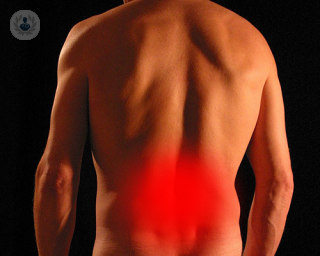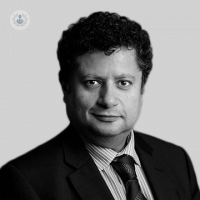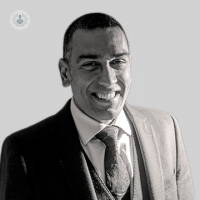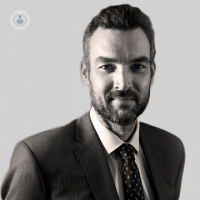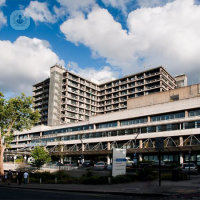Spinal surgery
Mr Sean Molloy - Orthopaedic surgery
Created on: 05-25-2017
Updated on: 10-24-2024
Edited by: Conor Dunworth
What is spinal surgery?
Spinal surgery consists of performing surgery to correct possible structural abnormalities.
Back injuries, and more specifically those of the spine, have become a problem that is affecting more and more people around the world. The passing of the years, accidents, overexertion and bad posture in everyday life are the causes of the problem.

Spine surgery allows surgeons to decompress, move and fix vertebral structures, and replace them if necessary. Back surgery is an option to consider when conservative treatments have not worked and the pain remains persistent and prevents the development of a normal life. There are several types of back surgery:
- Discectomy: This involves removing the herniated part of the disc to access the swollen nerve and relieve its irritation.
- Laminectomy: The bone covering the vertebrae is removed and enlarged to relieve pressure from a stenosis.
- Fusion: Spinal fusion consists mainly of joining two or more bones of the spine together. This can relieve pain by giving stability to a fracture or simply to eliminate the pain that begins with the movement of the vertebrae, which can degenerate or injure some of the vertebral discs.
- Disc implant: As an alternative to fusion, there is the implant of a disc, although it cannot be used by everyone.
Why is spinal surgery performed?
Spinal surgery is performed to correct spinal pathologies that cause pain. Back surgery is used to relieve the pain and/or numbness associated with this pain, which often radiates to other areas of the back, arms and legs.
Normally, back and spinal pain is caused by the compression of a nerve within it. Nerves can be compressed for several reasons. An example would be disc problems, such as a herniated disk, which can end up pressing too hard on a vertebra against the nerve. Occasionally, osteoarthritis causes excess bone in the spine.
What is spinal surgery?
There are different options for intervening on the spine. They are as follows:
Fusion
Fusion or vertebral arthrodesis is usually used in the following cases:
- There is instability, which can be caused by various causes, such as scoliosis or spondylolisthesis. In these cases, there is an excess of mobility in the spine.
- Arthrosis pain from hypertrophic arthrosis joints
- Deformities-when there is a deformity, such as from scoliosis
- Spinal stenosis
- Anterior cervical fusion: used to treat degenerative disc disease. Bone grafts are used to fuse the treated segment.
- Posterior cervical fusion:
- Posterior lumbar fusion
Surgical techniques
- Percutaneous techniques: these are injections or techniques such as radiofrequency denervation to relieve lumbar and cervical pain.
- Electro dermal therapy
- Vertebroplasty: This consists mainly of increasing the intraosseous space of a vertebra by injecting bone cement to add vertebral stability.
Decompression techniques
- Microdisectomy: used to remove herniated fragments from the intervertebral disc. One of the most commonly used procedures in spinal surgery is microdiscectomy with lumbar microdecompression.
- Microdecompression: used to treat canal stenosis
Preparing for spine surgery
The patient is usually admitted to the clinic where the operation will be performed one day before undergoing it. The anaesthesia tests, as well as the physical and preoperative exams, will already be done at the time of the patient's admission.
They should not eat or drink anything for at least 12 hours before surgery begins. Apart from the basic aspects, spinal surgery does not require any special preparation, although you should be prepared to face the weeks of recovery, when you may need the help of a family member or companion to get used to activities little by little.
Care after spinal surgery
Normally, the patient will be admitted under observation for several days, and once he or she returns home he or she will have to face recovery.
It is important to keep the wound clean and follow the instructions or recommendations provided by the specialist. If the patient has undergone a discectomy, it is common for the patient to feel pain or weakness, although recovery is quick and symptoms should improve markedly within one to two weeks after surgery.
In cases of fusion surgery, recovery is more complicated because you will need to rest and not return to your daily activities for at least three to four months, and bone healing may take more than a year to complete.
If the patient has undergone vertebral arthrodesis, he or she should rest and not perform daily activities for about two months.
Alternatives to spinal surgery
Today, there are several options for spinal surgery. In the surgical case, the main alternative to conventional surgery is by using minimally invasive techniques.
These minimally invasive surgical techniques allow access to the spine through tiny incisions with which the tissue to be treated and the surrounding tissue is barely damaged. Minimally invasive spine techniques achieve great results minimising the level of surgical aggression and offering the patient a shorter and less painful post-operative period.
In turn, there are other, more conservative methods for treating problems in the spine. Some are based on a combination of pain-reducing medications that are accompanied by occupational therapies and physical therapy exercises to strengthen the area.
Other treatments such as transcutaneous stimulation, radio frequency denervation or spinal cord neurostimulation may relieve chronic spinal problems and pain.





